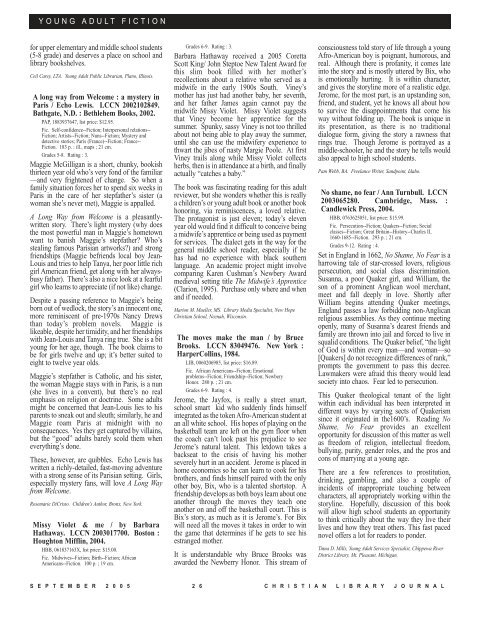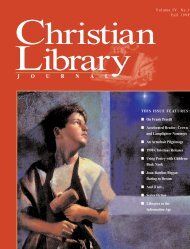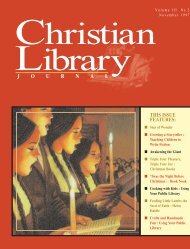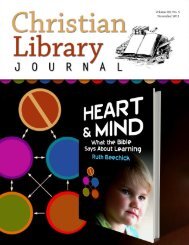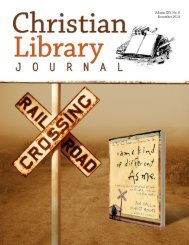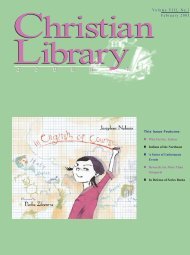book reviews - Christian Library Journal
book reviews - Christian Library Journal
book reviews - Christian Library Journal
Create successful ePaper yourself
Turn your PDF publications into a flip-book with our unique Google optimized e-Paper software.
YOUNG ADULT FICTION<br />
for upper elementary and middle school students<br />
(5-8 grade) and deserves a place on school and<br />
library <strong>book</strong>shelves.<br />
Ceil Carey, LTA. Young Adult Public Librarian, Plano, Illinois.<br />
A long way from Welcome : a mystery in<br />
Paris / Echo Lewis. LCCN 2002102849.<br />
Bathgate, N.D. : Bethlehem Books, 2002.<br />
PAP, 1883937647, list price: $12.95.<br />
Fic. Self-confidence--Fiction; Interpersonal relations--<br />
Fiction; Artists--Fiction; Nuns--Fiction; Mystery and<br />
detective stories; Paris (France)--Fiction; France--<br />
Fiction. 183 p. : ill., maps ; 21 cm.<br />
Grades 5-8. Rating : 3.<br />
Maggie McGilligan is a short, chunky, <strong>book</strong>ish<br />
thirteen year old who’s very fond of the familiar<br />
—and very frightened of change. So when a<br />
family situation forces her to spend six weeks in<br />
Paris in the care of her stepfather’s sister (a<br />
woman she’s never met), Maggie is appalled.<br />
A Long Way from Welcome is a pleasantlywritten<br />
story. There’s light mystery (why does<br />
the most powerful man in Maggie’s hometown<br />
want to banish Maggie’s stepfather? Who’s<br />
stealing famous Parisian artworks?) and strong<br />
friendships (Maggie befriends local boy Jean-<br />
Louis and tries to help Tanya, her poor little rich<br />
girl American friend, get along with her alwaysbusy<br />
father). There’s also a nice look at a fearful<br />
girl who learns to appreciate (if not like) change.<br />
Despite a passing reference to Maggie’s being<br />
born out of wedlock, the story’s an innocent one,<br />
more reminiscent of pre-1970s Nancy Drews<br />
than today’s problem novels. Maggie is<br />
likeable, despite her timidity, and her friendships<br />
with Jean-Louis and Tanya ring true. She is a bit<br />
young for her age, though. The <strong>book</strong> claims to<br />
be for girls twelve and up; it’s better suited to<br />
eight to twelve year olds.<br />
Maggie’s stepfather is Catholic, and his sister,<br />
the woman Maggie stays with in Paris, is a nun<br />
(she lives in a convent), but there’s no real<br />
emphasis on religion or doctrine. Some adults<br />
might be concerned that Jean-Louis lies to his<br />
parents to sneak out and sleuth; similarly, he and<br />
Maggie roam Paris at midnight with no<br />
consequences. Yes they get captured by villains,<br />
but the “good” adults barely scold them when<br />
everything’s done.<br />
These, however, are quibbles. Echo Lewis has<br />
written a richly-detailed, fast-moving adventure<br />
with a strong sense of its Parisian setting. Girls,<br />
especially mystery fans, will love A Long Way<br />
from Welcome.<br />
Rosemarie DiCristo. Children’s Author, Bronx, New York.<br />
Missy Violet & me / by Barbara<br />
Hathaway. LCCN 2003017700. Boston :<br />
Houghton Mifflin, 2004.<br />
HBB, 061837163X, list price: $15.00.<br />
Fic. Midwives--Fiction; Birth--Fiction; African<br />
Americans--Fiction. 100 p. ; 19 cm.<br />
Grades 6-9. Rating : 3.<br />
Barbara Hathaway received a 2005 Coretta<br />
Scott King/ John Steptoe New Talent Award for<br />
this slim <strong>book</strong> filled with her mother’s<br />
recollections about a relative who served as a<br />
midwife in the early 1900s South. Viney’s<br />
mother has just had another baby, her seventh,<br />
and her father James again cannot pay the<br />
midwife Missy Violet. Missy Violet suggests<br />
that Viney become her apprentice for the<br />
summer. Spunky, sassy Viney is not too thrilled<br />
about not being able to play away the summer,<br />
until she can use the midwifery experience to<br />
thwart the jibes of nasty Margie Poole. At first<br />
Viney trails along while Missy Violet collects<br />
herbs, then is in attendance at a birth, and finally<br />
actually “catches a baby.”<br />
The <strong>book</strong> was fascinating reading for this adult<br />
reviewer, but she wonders whether this is really<br />
a children’s or young adult <strong>book</strong> or another <strong>book</strong><br />
honoring, via reminiscences, a loved relative.<br />
The protagonist is just eleven; today’s eleven<br />
year old would find it difficult to conceive being<br />
a midwife’s apprentice or being used as payment<br />
for services. The dialect gets in the way for the<br />
general middle school reader, especially if he<br />
has had no experience with black southern<br />
language. An academic project might involve<br />
comparing Karen Cushman’s Newbery Award<br />
medieval setting title The Midwife’s Apprentice<br />
(Clarion, 1995). Purchase only where and when<br />
and if needed.<br />
Marion M. Mueller, MS. <strong>Library</strong> Media Specialist, New Hope<br />
<strong>Christian</strong> School, Neenah, Wisconsin.<br />
The moves make the man / by Bruce<br />
Brooks. LCCN 83049476. New York :<br />
HarperCollins, 1984.<br />
LIB, 0060206985, list price: $16.89.<br />
Fic. African Americans--Fiction; Emotional<br />
problems--Fiction; Friendship--Fiction; Newbery<br />
Honor. 280 p. ; 21 cm.<br />
Grades 6-9. Rating : 4.<br />
Jerome, the Jayfox, is really a street smart,<br />
school smart kid who suddenly finds himself<br />
integrated as the token Afro-American student at<br />
an all white school. His hopes of playing on the<br />
basketball team are left on the gym floor when<br />
the coach can’t look past his prejudice to see<br />
Jerome’s natural talent. This letdown takes a<br />
backseat to the crisis of having his mother<br />
severely hurt in an accident. Jerome is placed in<br />
home economics so he can learn to cook for his<br />
brothers, and finds himself paired with the only<br />
other boy, Bix, who is a talented shortstop. A<br />
friendship develops as both boys learn about one<br />
another through the moves they teach one<br />
another on and off the basketball court. This is<br />
Bix’s story, as much as it is Jerome’s. For Bix<br />
will need all the moves it takes in order to win<br />
the game that determines if he gets to see his<br />
estranged mother.<br />
It is understandable why Bruce Brooks was<br />
awarded the Newberry Honor. This stream of<br />
consciousness told story of life through a young<br />
Afro-American boy is poignant, humorous, and<br />
real. Although there is profanity, it comes late<br />
into the story and is mostly uttered by Bix, who<br />
is emotionally hurting. It is within character,<br />
and gives the storyline more of a realistic edge.<br />
Jerome, for the most part, is an upstanding son,<br />
friend, and student, yet he knows all about how<br />
to survive the disappointments that come his<br />
way without folding up. The <strong>book</strong> is unique in<br />
its presentation, as there is no traditional<br />
dialogue form, giving the story a rawness that<br />
rings true. Though Jerome is portrayed as a<br />
middle-schooler, he and the story he tells would<br />
also appeal to high school students.<br />
Pam Webb, BA. Freelance Writer, Sandpoint, Idaho.<br />
No shame, no fear / Ann Turnbull. LCCN<br />
2003065280. Cambridge, Mass. :<br />
Candlewick Press, 2004.<br />
HBB, 0763625051, list price: $15.99.<br />
Fic. Persecution--Fiction; Quakers--Fiction; Social<br />
classes--Fiction; Great Britain--History--Charles II,<br />
1660-1685--Fiction. 293 p. ; 21 cm.<br />
Grades 9-12. Rating : 4.<br />
Set in England in 1662, No Shame, No Fear is a<br />
harrowing tale of star-crossed lovers, religious<br />
persecution, and social class discrimination.<br />
Susanna, a poor Quaker girl, and William, the<br />
son of a prominent Anglican wool merchant,<br />
meet and fall deeply in love. Shortly after<br />
William begins attending Quaker meetings,<br />
England passes a law forbidding non-Anglican<br />
religious assemblies. As they continue meeting<br />
openly, many of Susanna’s dearest friends and<br />
family are thrown into jail and forced to live in<br />
squalid conditions. The Quaker belief, “the light<br />
of God is within every man—and woman—so<br />
[Quakers] do not recognize differences of rank,”<br />
prompts the government to pass this decree.<br />
Lawmakers were afraid this theory would lead<br />
society into chaos. Fear led to persecution.<br />
This Quaker theological tenant of the light<br />
within each individual has been interpreted in<br />
different ways by varying sects of Quakerism<br />
since it originated in the1600’s. Reading No<br />
Shame, No Fear provides an excellent<br />
opportunity for discussion of this matter as well<br />
as freedom of religion, intellectual freedom,<br />
bullying, purity, gender roles, and the pros and<br />
cons of marrying at a young age.<br />
There are a few references to prostitution,<br />
drinking, gambling, and also a couple of<br />
incidents of inappropriate touching between<br />
characters, all appropriately working within the<br />
storyline. Hopefully, discussion of this <strong>book</strong><br />
will allow high school students an opportunity<br />
to think critically about the way they live their<br />
lives and how they treat others. This fast paced<br />
novel offers a lot for readers to ponder.<br />
Tinna D. Mills, Young Adult Services Specialist, Chippewa River<br />
District <strong>Library</strong>, Mt. Pleasant, Michigan.<br />
S E P T E M B E R 2 0 0 5 2 6 C H R I S T I A N L I B R A R Y J O U R N A L


